Watford faced the huge challenge to stay in the Premier League facing Pep Guardiola’s Manchester City team on Tuesday evening. The task was made even more difficult as Watford announced the sacking of Nigel Pearson on Sunday just two days before this crucial game. Hayden Mullins and head of goalkeeping Graham Stack were placed in the hot seat with the big job to navigate The Hornets to safety.
Manchester City had added motivation coming into this game as they were looking for a quick response following their defeat in the FA Cup semi-final to Arsenal on Saturday. Pep Guardiola now has added pressure on him to succeed and claim the Champions League trophy to add to the Carabao Cup, which will not be enough alone, as The Citizens will use these remaining games to get up to the standard required before there tie with Real Madrid.
Manchester City certainly showed up with this intent as they fired four past Ben Foster in goal as Pep Guardiola’s side turned on the style as they breezed past The Hornets at Vicarage Road leaving their League status to be decided on the final day of the season.
This tactical analysis will focus on the tactics of both teams and explain how Watford looked to contain City with their well organised defensive shape before Pep Guardiola’s side eventually broke down and penetrated Watford’s defensive unit scoring two in the first half. This analysis will also look at how Watford responded by changing their shape in the second half which ultimately played right into City’s hands.
Lineups
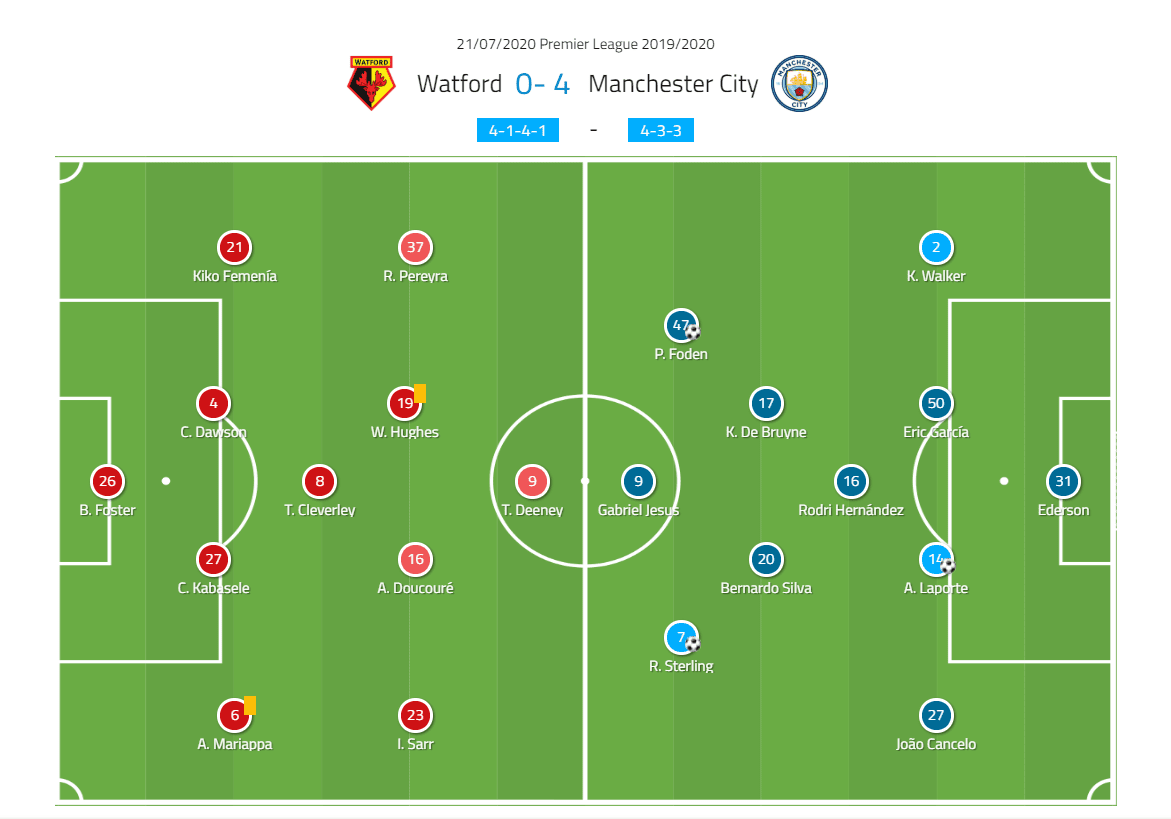
Mullins and Stack changed the team shape as they employed a 4-1-4-1 formation, with that they also made two personnel changes to the side that lost 3-1 to West Ham last Friday. The first change was made in the backline as Adam Mesina made way after he struggled against The Hammers for Adrian Mariappa who went to right-back. As a result, Kiko Fermina moved over to the left-back position to stop Man City’s deadly forward line. Watford’s other change for this game was the introduction of Roberto Pereyra a more traditional winger starting on the left flank for Danny Welbeck who started from the bench.
Guardiola set up his side in their usual 4-3-3 formation. The Spaniard did make changes, four in all, to his side that lost 2-0 to Arsenal in the FA Cup semi-final on the weekend. João Cancelo came into the side replacing Benjamin Mendy in the left-back position. Guardiola made two changes to his midfield three as Rodrigo came into the pivot position replacing Ĭĺkay Gündoğan and Bernardo Silva replaced David Silva. Man City’s final change was in the forward line as Phil Foden replaced Riyad Mahrez playing on the right side of the front three.
Watford employ a deep defensive block
With a limited amount of days to prepare for the mammoth task of facing Pep Guardiola’s Manchester City side, Hayden and Stark knew that the Citizens would have the majority of the possession and so smartly worked on their side’s shape out of possession. The Watford interim pair employed a deep defensive 4-5-1 formation that was both vertically and horizontally compact in order to limit the spaces for City to attack through.
Watford’s midfield line blocked access to the central channels through their three central midfielders, both wingers tucked back in behind them to mark and take account of City’s wide players so their defensive line could stay narrow and organised and were well set up to defend any forward balls into central/penalty area.
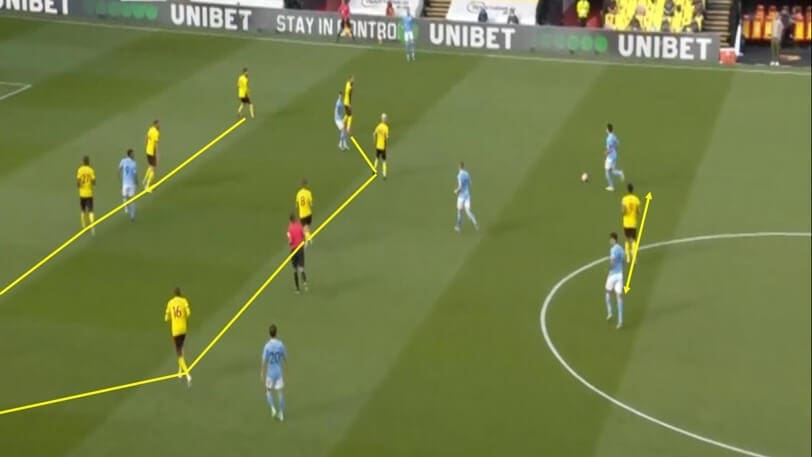
With Watford’s shape so compact it limited any space in between the lines as we see above, this forced City out to play around Watford’s defensive shape with their attacks predominantly being played out in the wide areas. Troy Deeney also ensured the ball was played out wide as he pressured City’s centre-backs with their only out ball being their full-backs out wide, early on.
Mullins and Stark added another element to defensive shape along with being narrow and compact where they instructed their left and right central midfielders to push out and protect the half-spaces where City always look to access. By positioning these players out in the half-space, as you can see below it ensures Watford match up and create numerical equally in these area’s and also negate the amount of influence City’s creative players who position themselves and operate to create chances in these spaces.

With the focus on protecting these area’s The Hornets were able to track any movements from City’s players who were position in the half-spaces and shut off many attacking moves as a result, which we can see below. Raheem Sterling has gone by his man in 1v1 and Bernardo Silva makes an underlapping run in the half-space which Sterling tries to find as he plays a through ball in behind.

However, Will Hughes is positioned near the City midfielder and is focused on stopping this and anticipates Bernardo’s move as he tracks the run and tackles the City player just as he runs onto the ball through, stopping his attacking efforts. Watford’s organised defensive shape really disrupted City’s attacking play and the setup from The Hornets made it difficult for them to create chances as they only managed to get one shot off, which was from long range, in the first half-hour of the game. Considering the reverse fixture they were 5-0 down at this stage, so a definite improvement in their play defensively against the former champions.
Guardiola’s clever tweak to his sides attacking play
City dominated possession as a result of Watford’s defensive shape, City attacked by using their usual triangular attacking shape in the half-spaces as they tried to overload these areas in order to access and penetrate these areas. In this shape, City’s winger provided the width, inside them the right/left central midfielder positioned themselves inside in the half-space, to make up this structural combination the full-backs were inverted deeper trying to engage Watford’s midfield line out to open up this space in behind them.
We can see this attacking shape below, but as aforementioned Watford were focused on protecting these half-spaces areas and have created numerical equality so the area is more congested and Watford are able to stop The Citizens’ effort to play through them.

Cancelo receives the ball and plays the ball into Kevin De Bruyne but he is surrounded by two Watford players who are able to surround him and stop the attack winning the ball back. This was the state of play before the first-half cooling break but after this interval, Guardiola implemented some clever tweaks to his sides play to eventually open up space to create chances.
When City then looked to access the half-space after the break they continued to form these triangular shapes but Guardiola instructed his wide player and ball near sided central midfielder to initially switch positions, the central midfielder now providing the width would make a run in behind almost as a decoy run early in the move running offside, this was the trigger to the winger (now operating inside) to vacate the half-space and move out to the wing, as the central midfielder would then curve there run back from their offside position into the space vacated in the half-space almost like a double interchange of positions, as we see below.
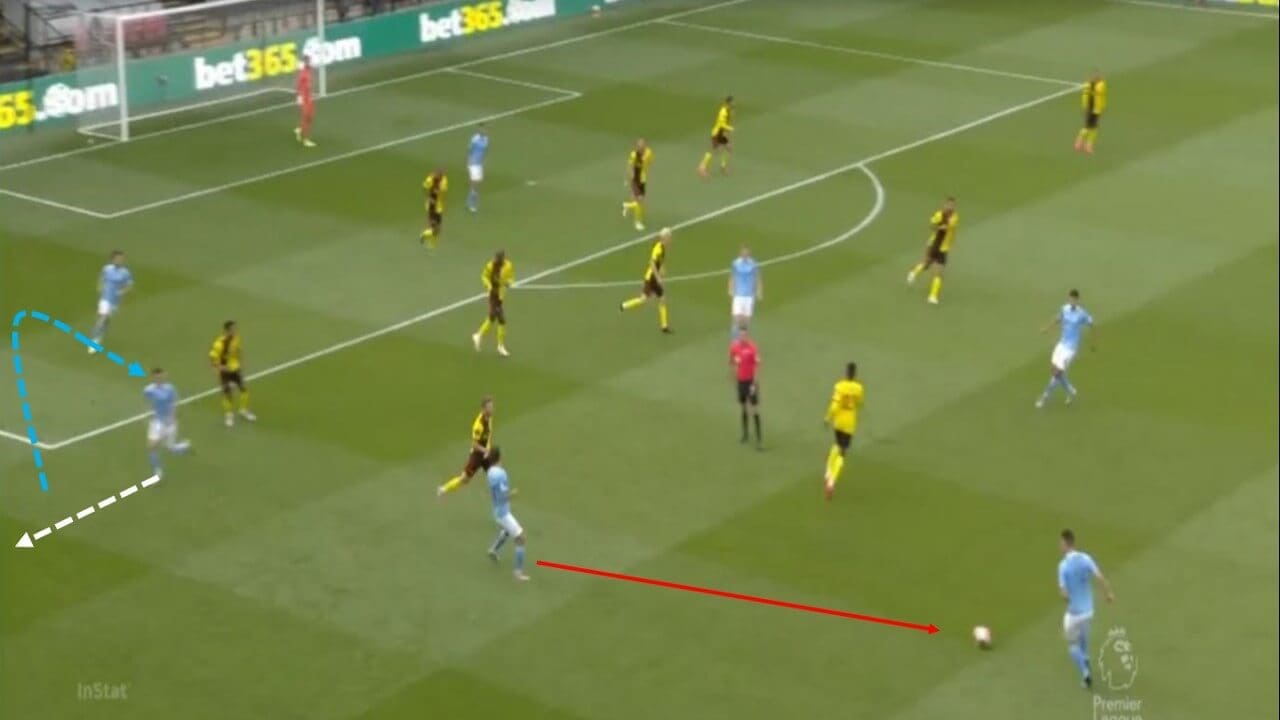
By Bernardo running offside, Watford switch off as they do not think he is a threat anymore and engage in the play that is developing in front of them almost forgetting about the Portuguese international as Cancelo plays the ball back to Aymeric Laporte who has come over to provide support to the move.
Bernardo is now free as a result in the half-space, the positioning and movement of his teammates are also crucial in opening up space so the ball can be played into him, as we see below. Foden with his movement from the half-space back to his position on the left-wing has pulled out Watford’s right-back horizontally, Cancelo’s position deeper has pulled Watford’s left-winger out of the space vertically.
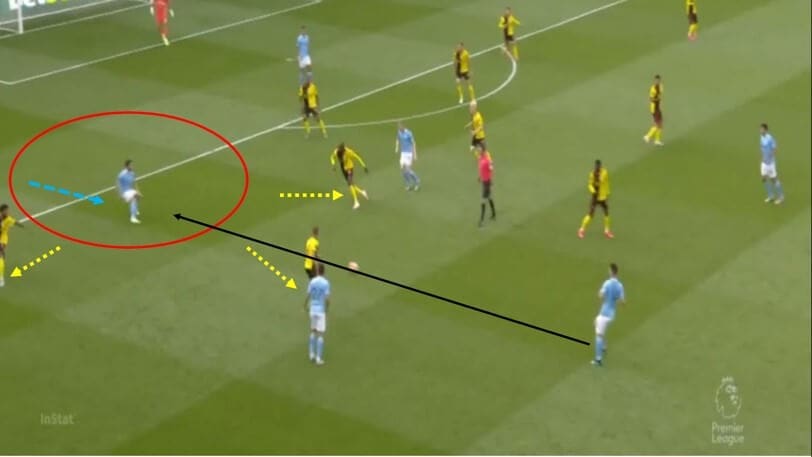
Also note the position of De Bruyne who has drifted across from the opposite side with engages Watford’s Abdoulaye Doucouré creating even more space for Bernardo as Laporte plays the ball into the free City midfielder who sets up a chance for City, a clever interchange of positions and manipulation of Watford’s defensive unit to access the half-spaces.
City provide more width which stretches Watford
Along with this clever movement and interchange of positions, Guardiola also switched a left-footer out to left-wing in Foden for Sterling (a right-footer) who switched to the right-wing, this change ensured his wingers provided more width, as they would not be cutting inside on their stronger foot moving into areas where it was more congested due to Watford’s narrow shape. This switch favoured City’s attacking play against Watford’s low block making the pitch as wide as possible as both wingers’ positions now stretched The Hornets lines horizontally.
As a result of this space opening up it created more favourable 1v1’s for City as they frequently switched the point of attack from right to left and vice versa as they probed Watford down one side and if they could not progress the ball would then switch the ball out to the now underloaded side (opposite wing) looking for an opening to attacking through, we can see how this method was used in the lead up to City’s opening goal below. As Sterling has the ball on the right, Man City’s right central-midfielder makes a crucial movement out to receive the ball.
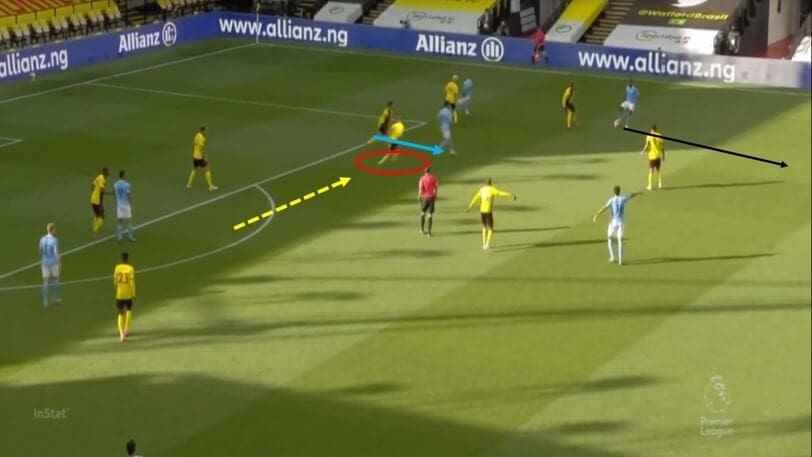
His movement out not only engages his marker but also Tom Cleverly (circled in red) who has been drawn across from his position from the middle of the central three in midfield as he tries to anticipate the ball into Bernardo. Sterling realises Cleverly as made a poor decision and as a result as left Watford light on the other side as he is not in the optimal position to move across to cover and help his team on the opposite side now.
As a result, Sterling smartly plays the ball back instigating the switch of play out to the left, as we can see below. Foden is now in a favourable 1v1 and receives the ball, Cleverly does well to get across (circled in red) but is not able to get over in time to double up on the City left-winger who is able to get his cross away.
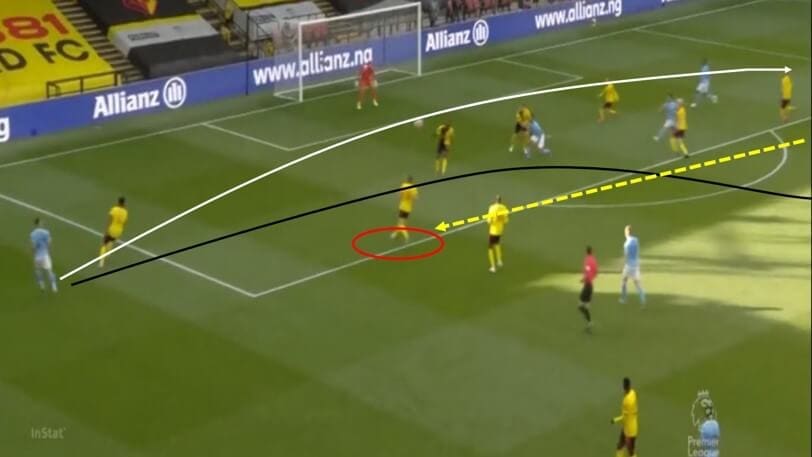
Foden’s cross is overhit but Kyle Walker is able to recover the ball on the right, the numerous switches of play have taken its told on Watford’s defensive unit as both Hughes and Watford’s left-back get attracted to the ball trying to recover across to stop the cross in and Sterling is able to find a pocket of space in the box. The left-sided Watford centre-back does not cover and mark the City winger in this space as he is expecting a deep cross into Gabriel Jesus so looking to outnumber him in the centre of the penalty area.
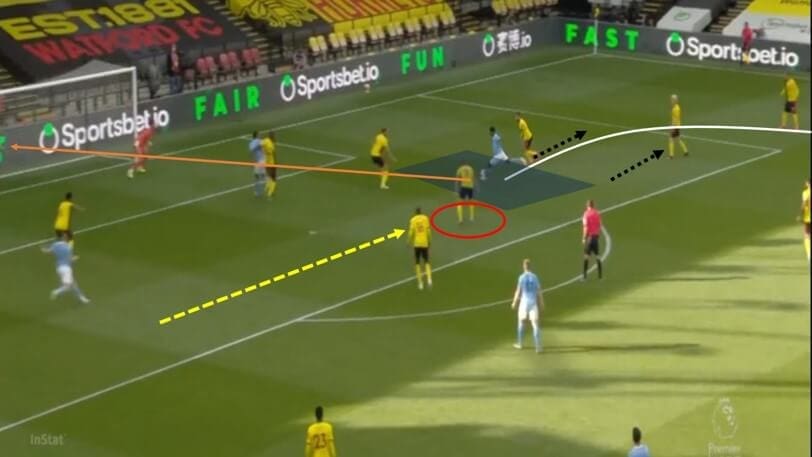
Cleverly who has been shuttling across horizontally does not have the energy to cover the required ground to get across to mark Sterling, as the cross is played in by Walker to Sterling who traps the ball well in space and he now has the time to set himself and finish well past Ben Foster in goal. City stretched Watford’s line really well and also kept them moving to increase the chances of them being disorganised, As a result, City punished Watford and capitalised on these moments.
Watford look to get back in the game but it plays straight into City’s hands
The Hornets were down 2-0 at half-time and rarely threaten City in attack as they employed such a deep defensive structure and as a result were pinned in their own half. Guardiola’s side could comfortably dominate territory and control the game as they attacked in waves and could commit more players forward as Watford offered no threat going forward in the first half.
Mullins and Stark looked to change this by moving into a 4-4-1-1 formation with Deeney playing behind Ismaila Sarr who was furthest forward as he played on the shoulder in between City’s centre-backs as Watford looked to take advantage of Man City’s high defensive line on the transition, we can see this setup from Watford below.

Initially, The Hornets at every available chance in the first 15 minutes of the second half when they won the ball back looked to play a searching ball long in behind, utilising the pace of Sarr but this attacking strategy was poorly constructed as even if he did latch onto the ball, he was outnumbered and isolated as his teammates were still far too deep so unable to support him in time before City could gain the ball back off him.
Watford, after a number of failed attempts of playing the ball behind for Sarr, pushed up their midfield line to look to add support and string a few attacking plays together in a bid to get a goal back to put themselves back in the game. However, by pushing up and coming out of their compact shape it opened up space in between the lines and so when City were able to win the ball back as Watford looked to build and play forward they left space in behind for City to exploit, as we can see below.
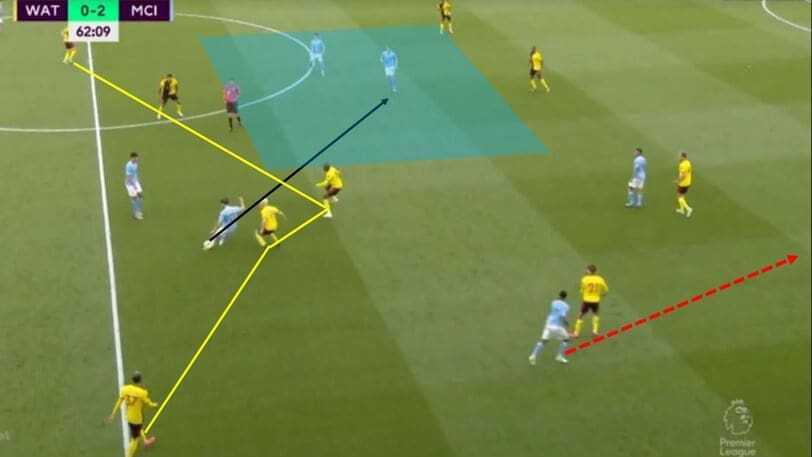
Guardiola’s men have won the ball in the middle third as Watford’s midfield is looking to combine in an attempt to move their play forward. As a result of Man City regaining the ball Watford’s midfield line is disjointed in transition which has left acres of space between the lines, leaving two City players free in this space. Bernardo is easily able to break this line with a pass into De Bruyne who has the time and space to turn and find the run of Sterling in behind and move ends with a goal for The Citizens making it 3-0 effectively ending the game.
Conclusion
Watford set out their stall to contain this City side who were looking for instant response to their failings in an FA Cup semi-final on the weekend. The Hornets did well to disrupt and stop City from creating chances in the first quarter of the game as they nullified the influence of City’s creative players as they employed a compact and narrow deep defensive block. Guardiola tinkered with his team and used clever tactical switches and positional rotations which resulted in City opening the scoring before grabbing a second just before half-time.
Mullins and Stark looked to get back into the game by changing their strategy, but with such little turnaround from their announcement that they would be taking charge of this game, it looked like this strategy was not prepared and as well thought out as their defensive plan to stop and contain City. Guardiola’s side was able to deal with this attacking plan from Watford and take advantage of the space as The Hornets came out of their compact shape, which played straight into City’s hands. Watford’s faith now comes down to the final game as relegation to The Championship looms closer.





Comments